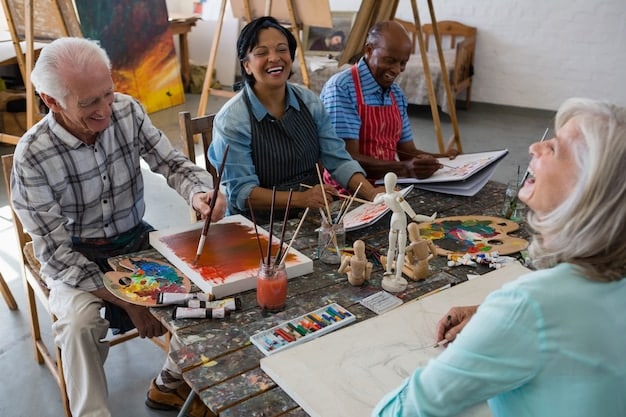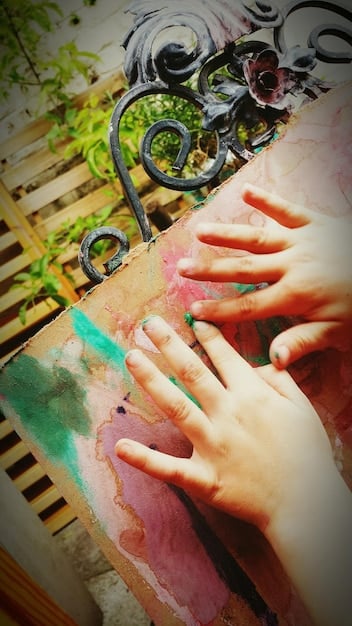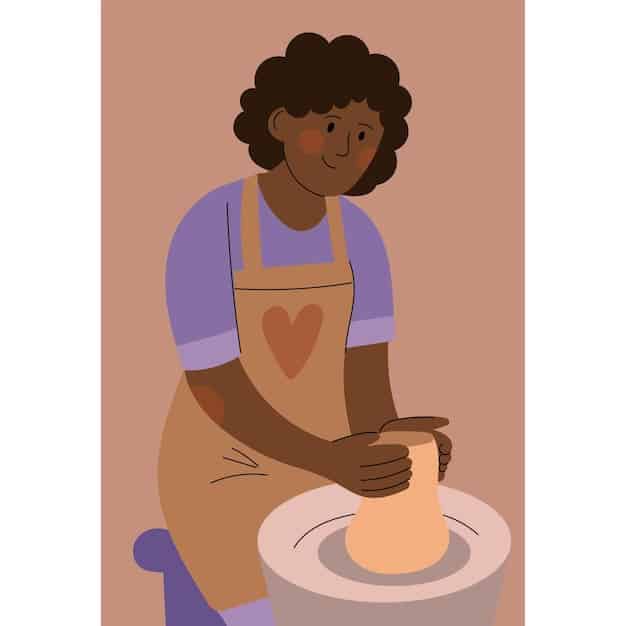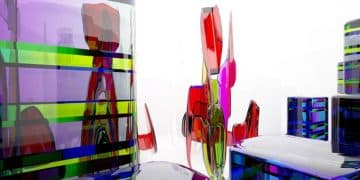Discover the Transformative Benefits of Art Therapy for Mental Health

Art therapy offers significant benefits for mental health by providing a creative outlet for emotional expression, reducing stress and anxiety, improving self-esteem, and enhancing overall psychological well-being.
Feeling overwhelmed, stressed, or disconnected? What are the benefits of art therapy for mental health? It’s a powerful, expressive approach that can help you unlock your emotions, reduce anxiety, and boost your self-esteem through creative exploration.
Understanding Art Therapy: A Creative Path to Healing
Art therapy is a form of psychotherapy that uses creative methods, such as painting, drawing, sculpting, and collage, to help individuals explore their emotions, improve self-awareness, and cope with stress and trauma. It’s not about artistic talent; it’s about using art as a means of communication and self-expression.
Unlike traditional talk therapy, art therapy allows individuals to express feelings and experiences that may be difficult to verbalize. This makes it particularly beneficial for those who struggle with communication or have experienced trauma.
The Core Principles of Art Therapy
At its core, art therapy operates on several guiding principles. These include the belief that everyone is capable of creative expression, the idea that the creative process is inherently healing, and the understanding that art can serve as a bridge between conscious and unconscious thoughts and feelings.
- Expressive Freedom: Art provides a safe space for exploring emotions without judgment.
- Therapeutic Relationship: A trained art therapist guides the process, offering support and insight.
- Process-Oriented: The focus is on the act of creating, rather than the final product.
The therapeutic relationship is crucial, as the therapist helps individuals to interpret their artwork and gain a deeper understanding of their emotional landscape.
Reducing Stress and Anxiety Through Art
One of the most widely recognized benefits of art therapy is its ability to reduce stress and anxiety. Engaging in creative activities can lower cortisol levels, the hormone associated with stress, and promote relaxation.
Art provides a distraction from daily worries and allows individuals to enter a state of flow, where they are fully immersed in the creative process. This can lead to a sense of calm and well-being.

How Art Lowers Stress Hormones
Studies have shown that engaging in art activities can decrease cortisol levels. The act of creating art can activate the parasympathetic nervous system, which is responsible for the “rest and digest” response, counteracting the effects of stress.
Moreover, the repetitive nature of many art forms, such as coloring or drawing patterns, can be meditative and promote a sense of calm.
Mindfulness and Art
Art therapy can also enhance mindfulness, the practice of paying attention to the present moment without judgment. By focusing on the sensory experience of creating art – the colors, textures, and movements – individuals can become more grounded and present.
This mindful approach can help reduce anxiety by shifting attention away from future worries or past regrets.
Boosting Self-Esteem and Confidence
Art therapy can be instrumental in boosting self-esteem and confidence. The act of creating something tangible and expressing oneself through art can foster a sense of accomplishment and pride.
Overcoming creative challenges and seeing progress in one’s artwork can also build self-efficacy, the belief in one’s ability to succeed in specific situations.
- Sense of Accomplishment: Completing an art project provides a tangible sense of achievement.
- Self-Expression: Art allows individuals to express their unique perspectives and feelings.
- Positive Feedback: Constructive feedback from a therapist can reinforce artistic efforts and build confidence.
The focus in art therapy is not on perfection, but rather on the process of exploration and self-discovery. This can help individuals to accept themselves more fully and appreciate their unique qualities.
Improving Emotional Regulation
Emotional regulation, the ability to manage and respond to emotions in a healthy way, is a crucial aspect of mental well-being. Art therapy provides a safe and structured environment for individuals to explore and regulate their emotions.
By externalizing feelings through art, individuals can gain a greater understanding of their emotional patterns and develop coping strategies for managing difficult emotions.
Identifying and Expressing Emotions
Art therapy can help individuals identify and express emotions that they may have difficulty articulating verbally. The process of creating art can serve as a catalyst for emotional awareness, bringing unconscious feelings to the surface.
For example, using colors, shapes, and symbols in art can represent different emotions, allowing individuals to externalize and examine their feelings in a non-threatening way.
Developing Coping Strategies
Through art therapy, individuals can develop new coping strategies for managing difficult emotions. The therapist can guide them in exploring different techniques and materials to find what works best for them.
- Grounding Techniques: Using tactile materials like clay or sand can help ground individuals in the present moment during times of emotional distress.
- Emotional Release: Expressive art forms like painting or drawing can provide an outlet for releasing pent-up emotions.
- Cognitive Reframing: Creating art that challenges negative thought patterns can help individuals reframe their perspectives.
Art Therapy for Trauma Recovery
Art therapy is a valuable tool in trauma recovery, as it allows individuals to process traumatic experiences in a non-verbal way. Trauma can often be difficult to articulate, and art provides an alternative means of expression.
By creating art that represents their trauma, individuals can gain a sense of control over their experiences and begin to heal from the emotional wounds.

Creating a Safe Space for Expression
Art therapy offers a safe and supportive environment for individuals to explore their trauma. The therapist provides guidance and encouragement, helping individuals to process their experiences at their own pace.
The act of creating art can also be empowering, as it allows individuals to reclaim their narrative and create a new story of resilience.
Processing Traumatic Memories
Through art, individuals can begin to process traumatic memories in a controlled and manageable way. The therapist can help them to identify triggers, explore their emotions, and develop coping strategies for dealing with difficult feelings.
- Visualizing Trauma: Creating images that represent traumatic events can help individuals to confront their memories and begin to heal.
- Symbolic Representation: Using symbols and metaphors in art can allow individuals to express emotions that are difficult to verbalize.
- Narrative Reconstruction: Creating art that tells a new story of resilience and recovery can help individuals to rewrite their trauma narrative.
Enhancing Communication Skills
Art therapy can enhance communication skills, particularly for those who struggle with verbal expression. Art provides an alternative means of communication, allowing individuals to express themselves non-verbally.
By sharing their artwork and discussing their creative process, individuals can also improve their interpersonal skills and build stronger relationships.
Non-Verbal Communication
Art therapy is particularly beneficial for individuals who have difficulty expressing themselves verbally. Art provides a way to communicate emotions and experiences that may be difficult to articulate.
This can be especially helpful for children, individuals with autism, or those who have experienced trauma that has impaired their verbal abilities.
Interpersonal Skills
By sharing their artwork and discussing their creative process, individuals can improve their interpersonal skills. Art therapy provides a context for building trust, empathy, and understanding.
The therapist can also provide feedback and guidance, helping individuals to develop more effective communication strategies.
| Key Point | Brief Description |
|---|---|
| 🎨 Emotional Expression | Art provides a non-verbal outlet for exploring and expressing feelings. |
| 🧘 Stress Reduction | Creative activities lower cortisol levels and promote relaxation. |
| 💪 Self-Esteem Boost | Creating art fosters a sense of accomplishment and pride. |
| 🗣️ Communication Skills | Art therapy enhances non-verbal and interpersonal communication skills. |
Frequently Asked Questions About Art Therapy
▼
Art therapy is a form of psychotherapy that uses creative methods to explore emotions, improve self-awareness, and cope with stress. It involves creating art with the guidance of a trained therapist to process feelings and experiences.
▼
No, artistic skill is not required. The focus of art therapy is on the process of creating, not the final product. It’s about expressing yourself and exploring your emotions through art, regardless of your artistic abilities.
▼
Art therapy can benefit individuals of all ages, including children, adolescents, and adults. It’s often used to treat mental health conditions such as anxiety, depression, PTSD, and other emotional and psychological challenges.
▼
Art therapy provides a non-verbal way to process traumatic experiences that are difficult to articulate. Creating art can help individuals gain a sense of control, express their emotions, and begin to heal from the emotional wounds of trauma.
▼
A variety of art forms can be used in art therapy, including painting, drawing, sculpting, collage, and digital art. The specific techniques used will depend on the individual’s needs and preferences, as well as the therapist’s approach.
Conclusion
In conclusion, art therapy offers a multitude of benefits for mental health, from reducing stress and anxiety to boosting self-esteem and enhancing communication skills. By providing a creative outlet for emotional expression and a safe space for self-discovery, art therapy can be a powerful tool in promoting overall well-being and healing.





